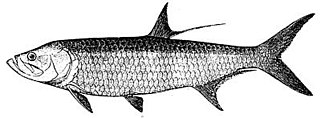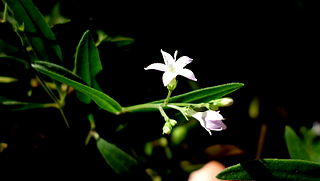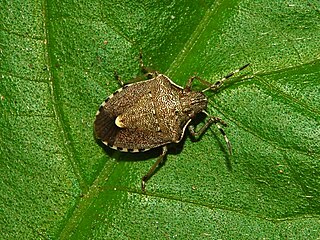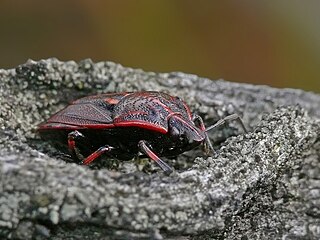
The Elopiformes are the order of ray-finned fish including the tarpons, tenpounders, and ladyfish, as well as a number of extinct types. They have a long fossil record, easily distinguished from other fishes by the presence of an additional set of bones in the throat.

The spotted shag or pārekareka is a species of cormorant endemic to New Zealand. Though originally classified as Phalacrocorax punctatus, it is sufficiently different in appearance from typical members of that genus that for a time it was placed in a separate genus, Stictocarbo, along with a similar species, the Pitt shag. Subsequent genetic studies show that the spotted shag's lineage is nested within the typical shags.

Pentatomidae is a family of insects belonging to the order Hemiptera, generally called shield bugs or stink bugs. Pentatomidae is the largest family in the superfamily Pentatomoidea, and contains around 900 genera and over 4700 species. As hemipterans, the pentatomids have piercing sucking mouthparts, and most are phytophagous, including several species which are severe pests on agricultural crops. However, some species, particularly in the subfamily Asopinae, are predatory and may be considered beneficial.

Dynastinae or rhinoceros beetles are a subfamily of the scarab beetle family (Scarabaeidae). Other common names – some for particular groups of rhinoceros beetles – include Hercules beetles, unicorn beetles or horn beetles. Over 1,500 species and 225 genera of rhinoceros beetles are known.

Pentodon is a genus of plants belonging to the family Rubiaceae. There appear to be only two species in the genus. They are found in Central America, Central and Southern Africa and the Seychelles.

Tomarus is a genus of scarab beetles in the subfamily Dynastinae, the rhinoceros beetles. They are native to the Americas, where they are distributed from the central United States to Argentina, and a few species occur in the Caribbean.

Balistes punctatus, the bluespotted triggerfish or spotted triggerfish, is a species of marine ray-finned fish belonging to the family Balistidae, the triggerfishes. This species occurs in the Eastern Atlantic Ocean off the Western coast of Africa.

Oryctes is the most economically important genus of rhinoceros beetles in the subfamily Dynastinae, since it includes a notorious insect pest of palms.

Trypodendron is a genus of ambrosia beetles of the family Curculionidae. There are at least 30 described species in Trypodendron.

Holcostethus is a genus of shield bugs belonging to the family Pentatomidae, subfamily Pentatominae. These bugs are also known as stink bugs from their foul odor.

Dorcadion is a genus of longhorn beetles of the subfamily Lamiinae.

Eodorcadion is a genus of longhorn beetles of the subfamily Lamiinae, containing the following species:

Pentodontini is a tribe of rhinoceros beetles in the family Scarabaeidae. There are over 100 genera in the tribe Pentodontini.

Phileurus is a genus of rhinoceros beetles in the family Scarabaeidae. There are more than 20 described species in Phileurus.

Archophileurus is a genus of rhinoceros beetles in the family Scarabaeidae. There are at least 30 described species in Archophileurus.

Oryctini is a tribe of beetles in the Dynastinae.

Phyllognathus is a genus of beetles belonging to the family Scarabaeidae, subfamily Dynastinae.

Enoplops is a genus of Palaearctic bugs, in the family Coreidae and tribe Coreini. Species are recorded from Europe and includes E. scapha found in the British Isles; there are also records from North Africa and China.

Jalla is a genus of European shield bugs in the subfamily Asopinae erected by Carl Wilhelm Hahn in 1832. The type species Jalla dumosa is recorded from northern Europe including the British Isles.




















